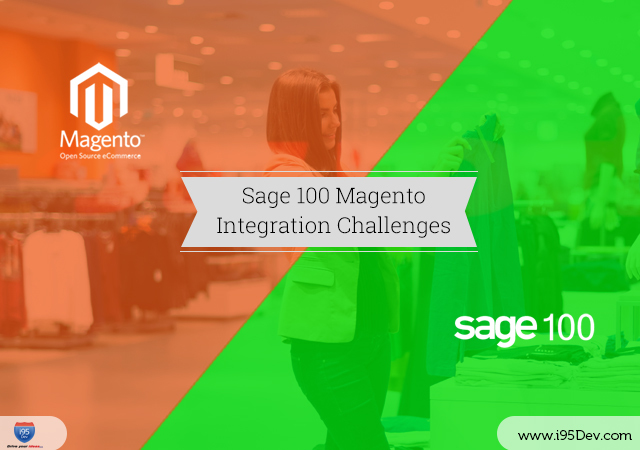Sage 100 Magento
Integration Challenges

Why Sage 100 and Magento Integration
Sage 100 is one of the most popular SME ERP software that is used by thousands of companies and hundreds of thousands of users. Sage 100 caters to the logistics and financial solutions that help companies manage their material business. Magento, on the other hand, provides one of the most popular eCommerce platforms for merchants to manage their sales over the cloud with a few hundreds of thousands of merchants adopting Magento for their sales.
The number of companies adopting eCommerce has only increased in due course with a global business value estimated at USD 4135 billion by 2020. In short, all companies that sell products would consider adopting eCommerce to increase their sales and would need effective software to run their business in all aspects. The popularity and patronage of SAGE 100 Magneto as mid-market ERP solution and Magento as an eCommerce solution makes it a compelling reason to integrate the two and reap the benefits of a combined solution that connects the customer with the company.
There are challenges in achieving this but these can be surmounted; it is our aim to discuss in this blog about what these challenges and why it is important to consider them.
Challenges in integration and deployment
There are quite a few major challenges that could be faced in achieving the integrating between Sage 100 and Magento:
- Rigidity Vs Flexibility: Backend is meant to be af rigid solution, whereas eCommerce requires flexibility and speed. Backend solutions such as Sage ERP that help run business background processes such as Manufacturing, Procurement, Sales and Distribution; these are run based on rules and are rigid to a considerable extent. In contrast, front-end solutions such as Magento eCommerce provide a lot of flexibility, navigation, and speed of operation.
- Accuracy and Timeliness: The integration for Sage with Magneto would have to be tight, so that important information like inventory data required for stock check and release happens to be in near real-time for the data between Sage 100 and Magento. This requires data synchronization and distribution across the two sides to be even and consistent. This may directly affect the quality of user experience while placing the orders on the front end.
- Custom Vs off-the-shelf solution: While it could be tempting to go for a custom solution for the integration between Sage and Magento as this could be warranted by numerous customizations built on the two sides, building and maintaining the same could be expensive as well as cumbersome. The costs of implementations could be weighed against the gains obtained by the acquired integration.
- Migrating from older and different versions: Consistency of the integration must be maintained while migrating either of the implementations from the older version to a newer version.
- Data consistency across platforms: While terms like demand, customer orders, fulfillment, and such other details could be primarily associated with Magento eCommerce systems, terms like product info, supply, availability, release, shipment and such other details originate from Sage ERP systems. Information like these must be synchronized all the time. Failure to achieve this would result in wrong stock availability info, incorrect demand, lost orders, product returns, and eventually even lost customers.
- Other technical challenges: There are other technical challenges that must be considered. Both or either of the systems could collapse necessitating restoration of backups. In such cases, it is necessary to ensure data is consistent on either of the sides. Another challenge is to list all assumptions made for each scale of integration; this can be done by keeping the objective of ensuring data consistency on either side. Data type inconsistency, performance issues, and access controls also could pose challenges in achieving effective integration. The integration must not lead to the sacrifice of any important features on either of the sides; the benefits of either of the systems must stay intact.
As experienced implementers of Sage integration, we offer solutions to many such challenges. There are many reasons and benefits that make it compelling to choose the integration between Sage ERP and Magento.
Benefits of integrating Sage 100 with Magento
It is the benefits of the integration between the two systems that beckon to overcome the associated challenges and problems with Magneto-Sage 100 integration that are discussed above. Some or all of the benefits like in the list below are possible with effective integration of the two:
- Improves the overall user experience and customer satisfaction: Makes it possible to have near real-time processing. Minimizes data error otherwise caused due to manual data entry. Renders faster order entry and processing by accurate and reliable availability. This could eventually lead to reduced order processing costs.
- Optimizes employee time and effort: By eliminating the manual data entry of customer orders, employees can be used for other purposes. Consistency of data across the systems helps employees to provide and deal with reliable information. By always providing accurate availability information, helps the company avoid under or overselling. It also improves traceability and accountability of employees by improved visibility of detailed.
- Optimizes data: Only relevant data resides on either side by avoiding data duplication as far as possible. Provides consistent and near real-time inventory updates on either of the sides. The data flow on either side of the system with every transaction makes it possible to keep the relevant data synchronized.
While each of the sides has its own importance and feature list, the integration between the two clearly adds more in terms of people, processes, and costs.
Conclusion
Every integration comes with its own challenges and Sage ERP – Magento is no exception and in fact, may provide unique scenarios. We reckon challenges like these and many more as we continue to evolve effective Sage-Magento integration for many of our customers. To know more about our products and services or to know how we can help you, contact us today.




